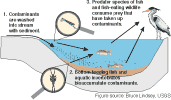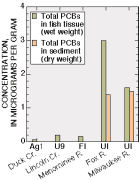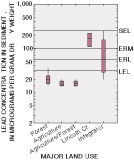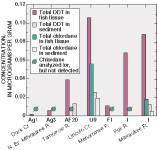Water Quality in the Western Lake Michigan Drainages, Wisconsin and Michigan, 1992-95
Table of contents || Previous section || Next section || Glossary
Industrial activities in urban areas of the study area have introduced contaminants into surface water and stream-bed sediments. Parts of the Menominee, Fox, Sheboygan, and Milwaukee Rivers have been designated “areas of concern” (AOCs) by the International Joint Commission, which represents U.S. and Canadian environmental and resource interests in the Great Lakes Region (International Joint Commission, 1989). Water, sediment, and biota in these four AOCs have been found to contain a wide array of inorganic and synthetic organic compounds (Wisconsin Department of Natural Resources, 1978 and 1993; Sullivan and Delfino, 1982). The severity of contamination in the AOCs has restricted the use of water for human and animal consumption and has limited the recreational uses.
 (71,916 bytes)
(71,916 bytes)
The industrialized lower Fox River Valley supports one of the largest concentrations of paper mills in the world.
Concentrations of chemicals in the aquatic environment are of concern whenever and wherever organisms, including humans, may be at risk. One way to assess this risk is to measure the amount of contaminants biologically available to organisms, known as bioavailability. Measuring concentrations of contaminants in streambed sediments and in biotic tissues can provide information on the bioavailability of contaminants in sediments to particular organisms.
 (13,857 bytes)
(13,857 bytes)
Contaminants attached to sediments can be transported from the land surface to surface water systems. The contaminants can enter the food chain and lead to bioaccumulation in larger species.
Polychlorinated biphenyls (PCBs), a set of 209 related chlorinated organic compounds, had various industrial uses in the study area such as in hydraulic fluids, cutting oils, sealants, and pesticides. Despite a manufacturing ban in the mid-1970s, PCBs continue to be of concern because of their persistent toxicity to organisms. PCBs are a listed contaminant in all of the designated AOCs.
 (5,602 bytes)
(5,602 bytes)
Concentrations of PCBs are 10 times higher in streambed sediments and biotic tissues at urban Integrator sites (Scudder and others, 1997) than in smaller urban, agricultural or forested land use areas. RHU labels correspond to the RHU figure on p. 6, "I" represents large-river (Integrator) sites.
Data collected during the bed-sediment and tissue studies in the study area indicate that PCB concentrations in the Lower Fox River and in the Milwaukee River may be linked to algal productivity. Highest particulate PCB concentrations were measured during the algae-rich summer months. Incorporation of PCBs into algae (Swackhamer and Skoglund, 1993) provides a pathway for these compounds to move from contaminated river sediments into other organisms, including fish and humans.
 (5,273 bytes)
(5,273 bytes)
The relation between algae measured as chlorophyll-a and PCBs indicates that algal growth, sedimentation, and sediment resuspension may be important processes controlling the fate of PCBs in rivers (Fitzgerald and Steuer, 1996).
Acute exposure (short term, high concentration) to certain trace elements can kill organisms, whereas chronic exposure (long term, low concentration) can result in mortality or nonlethal effects, such as stunted growth, reduced reproductive success, or deformities.
Concentrations of cadmium, copper, mercury, nickel, lead, and zinc were significantly higher in fine river sediments from large-river and urban sites than in other areas (Scudder and others, 1997). Trace elements and synthetic organic compound concentrations in sediment and fish tissue exceeded aquatic-life criteria at some sites.
|
Trace |
Number of |
OMEE |
SEC |
OMEE |
SEC |
|---|---|---|---|---|---|
|
Arsenic |
|
18 | 12 | 1 | 1 |
|
Cadmium |
|
25 | 19 | 0 | 2 |
|
Chromium |
|
42 | 38 | 3 | 1 |
|
Copper |
|
30 | 9 | 3 | 0 |
|
Mercury |
|
8 | -- | 2 | -- |
|
Nickel |
|
25 | 16 | 0 | 0 |
|
Lead |
|
12 | 10 | 1 | 5 |
|
Zinc |
|
17 | 17 | 1 | 3 |
Trace-element concentrations in fine (less than 63 micrometers) streambed sediment exceeded guidelines for bulk sediment in many samples. Comparisons of trace-element concentrations in fine sediment to bulk sediment guidelines may overestimate potential effects on biota. A number of observations from the Western Lake Michigan Drainages equaled or exceeded published guidelines for trace-element concentrations in sediment.
[Ontario Ministry of Environment and Energy values (Persaud and others, 1993) are for the Lowest Effect Level (OMEE LEL) and Severe Effect Level (OMEE SEL). The sediment effect criteria (SEC) are from Ingersoll and others (1996) for Effects Range Low (SEC ERL) and Effects Range Median (SEC ERM); --, no guidelines.]
 (5,319 bytes)
(5,319 bytes)
Median concentrations of lead and mercury in streambed sediment exceeded the "lowest effect level" at urban and large river sites (see table at right). Lead is a known urban contaminant whose historical source is probably gasoline (Callender and Van Metre, 1997).
 (10,692 bytes)
(10,692 bytes)
Concentrations of many toxic synthetic organic compounds were elevated in streambed sediments and tissues from urban and large-river sites relative to other land uses. (RHU labels refer to RHU figure on p. 6; "I" represents large-river (Integrator) sites.
Semivolatile organic compounds (SVOCs) were analyzed for in stream-bed sediments. Eighty percent of the SVOCs analyzed for in the study area were detected in at least one sample. Two classes of SVOCs (polycyclic aromatic hydrocarbons, PAHs, and phthalates) were detected more frequently and in higher concentrations at urban-affected sites (Scudder and others, 1997).
U.S. Geological Survey Circular 1156
Table of contents || Previous section || Next section || Glossary
Suggested citation:
C. A. Peters, D. M. Robertson, D. A. Saad, D. J. Sullivan, B. C. Scudder, F. A. Fitzpatrick, K. D. Richards, J. S. Stewart, S. A. Fitzgerald, and B. N. Lenz, 1998, U.S. Geological Survey Circular 1156, on line at <URL: https://water.usgs.gov/pubs/circ1156>, updated June 11, 1998